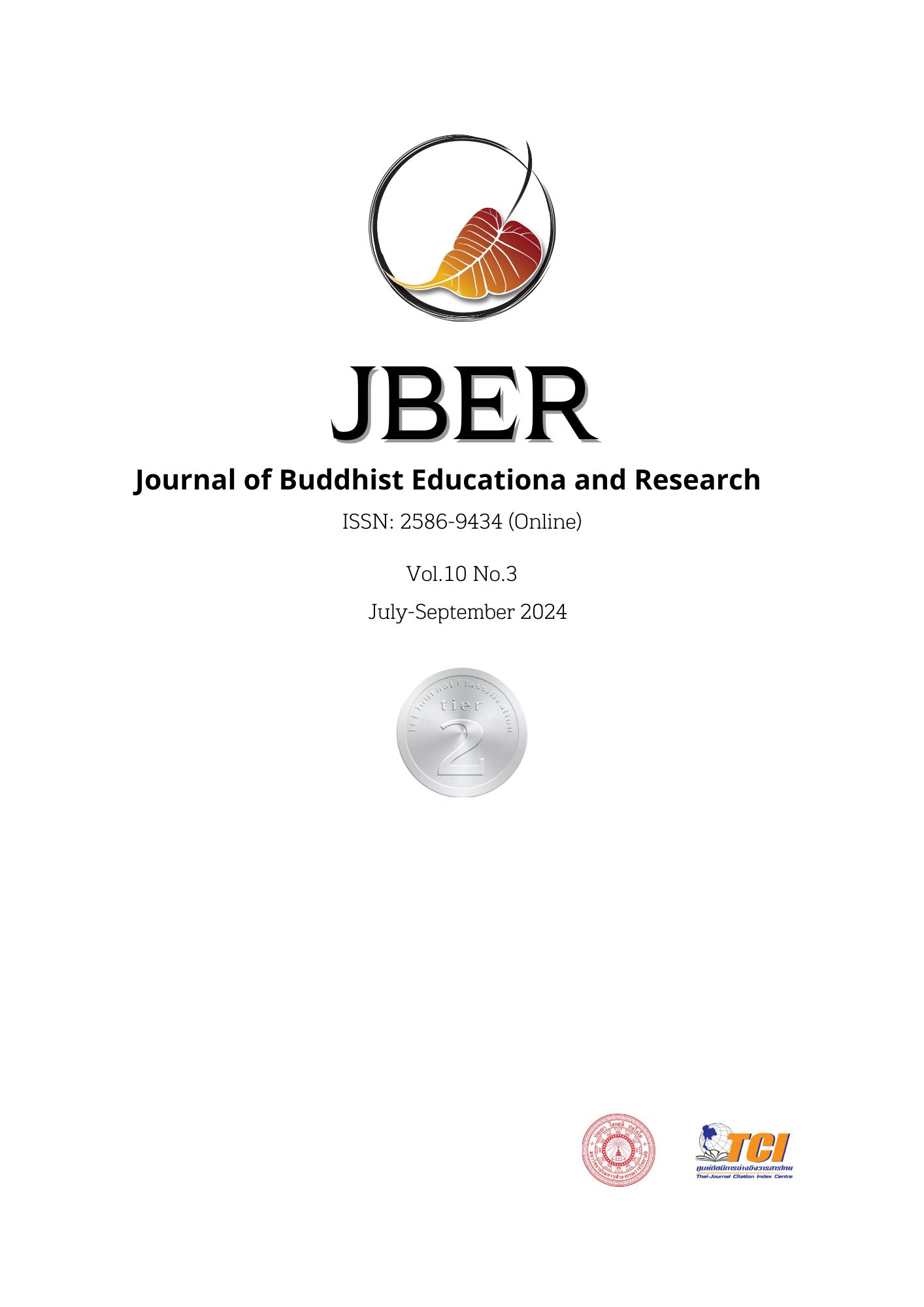The Development of a Learning Management Model Based on the Four Noble Truths to Promote Creative Problem-solving Skills among Undergraduate Students at Mahamakut Buddhist University, Isan Campus
Abstract
This research aimed to study the current state, development, and implementation of a learning management model based on the Four Noble Truths to promote creative problem-solving skills among undergraduate students at Mahamakut Buddhist University, Isan Campus. The target group consisted of 50 undergraduate students majoring in Social Studies Teaching, selected through purposive sampling. The research tools included the learning management model, a user guide for the model, instructional management plans, a knowledge test, and a satisfaction questionnaire. The statistics used for data analysis were the mean, standard deviation, t-test, and content analysis. The research findings revealed that the overall state of learning management based on the Four Noble Truths to promote creative problem-solving skills was at a moderate level (X̅ = 3.25, S.D. = 0.80), according to the opinions of second-year students. Additionally, the evaluation of the suitability of the learning management model found that the overall suitability was at a high level (X̅ = 4.35, S.D. = 0.63), indicating that this model is appropriate for use in the teaching and learning process. The comparison of pre-test and post-test scores using the learning management model based on the Four Noble Truths showed that the average post-test scores were significantly higher than the pre-test scores at the .05 level. The average pre-test score was 32.00 (S.D. = 4.44), while the average post-test score was 49.68 (S.D. = 3.86). These results clearly demonstrate the effectiveness of the model in promoting students' creative problem-solving skills. In conclusion, the use of the learning management model based on the Four Noble Truths is an effective approach to developing students' problem-solving skills. It not only fosters creativity and confidence in facing challenges but also enables students to apply the Four Noble Truths effectively in solving everyday problems.
References
Bonwell, C. C., & Eison, J. A. (1991). Active learning: Creating excitement in the classroom. School of Education and Human Development, George Washington University.
Creswell, J. W., & Clark, V. L. P. (2011). Designing and conducting mixed methods research (2nd ed.). SAGE Publications.
Joyce, B., & Weil, M. (2009). Models of teaching (9th ed.). Pearson Education.
Kolb, D. A. (1984). Experiential learning: Experience as the source of learning and development. Prentice-Hall.
Schweisfurth, M. (2013). Learner-centered education in international perspective: Whose pedagogy for whose development? Routledge.
จิตติ สุขุมศักดิ์. (2558). ทักษะการคิดเชิงสร้างสรรค์. นครราชสีมา: สำนักพิมพ์ศรีนคร.
ชลิตา สร้อยสังวาลย์. (2560). การคิดเชิงวิจารณญาณสำหรับครู. กรุงเทพฯ: สำนักพิมพ์ศูนย์วิจัย.
ธนพล ชัยเจริญ. (2560). ความสามารถในการแก้ปัญหาของคนรุ่นใหม่. กรุงเทพฯ: สำนักพิมพ์ธรรมสภา.
นพดล กาญจนประดิษฐ์. (2561). การพัฒนาทักษะการแก้ปัญหา. เชียงใหม่: สำนักพิมพ์การศึกษา.
ประสิทธิ์ สืบสำเนียง. (2561). การพัฒนานวัตกรรมการเรียนรู้. นครราชสีมา: สำนักพิมพ์สันติสุข.
ประสิทธิ์ สืบสำเนียง. (2561). การวิเคราะห์ปัญหา. กรุงเทพฯ: สำนักพิมพ์สยามการศึกษา.
พรรณี เจริญชัย. (2561). การพัฒนาทักษะการคิด. นครปฐม: สำนักพิมพ์มหาวิทยาลัย.
ภูมิ สินทรัพย์. (2560). การแก้ปัญหาที่มีประสิทธิภาพ. ขอนแก่น: สำนักพิมพ์มหาวิทยาลัย.
มนัส ทิพย์สุวรรณ. (2561). การคิดเชิงบูรณาการในยุคใหม่. อุบลราชธานี: สำนักพิมพ์อุบลการพิมพ์.
มนูญ ศรีวิชัย. (2560). ทักษะชีวิตสำหรับคนรุ่นใหม่. กรุงเทพฯ: สำนักพิมพ์ธรรมสภา.
มาลี สุวรรณภูมิ. (2562). มาตรฐานการศึกษาสำหรับครู. กรุงเทพฯ: สำนักพิมพ์มหาวิทยาลัย.
วิสุทธิ์ แสงสว่าง. (2561). การวิเคราะห์ปัญหาทางสังคม. กรุงเทพฯ: สำนักพิมพ์วิทยาการ.
วีระพงษ์ สงวนศักดิ์. (2559). การคิดวิเคราะห์เชิงสร้างสรรค์. พิษณุโลก: สำนักพิมพ์มหาวิทยาลัยนเรศวร.
ศิริพร ทิพย์หิรัญ. (2563). การแก้ปัญหาเชิงสร้างสรรค์ในห้องเรียน. เชียงใหม่: สำนักพิมพ์มหาวิทยาลัยเชียงใหม่.
สมชาย ภูมิชาติ. (2560). แผนการศึกษาแห่งชาติ. กรุงเทพฯ: สำนักพิมพ์ธรรมสภา.
สมศักดิ์ สร้อยสุวรรณ. (2562). การศึกษาในศตวรรษที่ 21. ขอนแก่น: สำนักพิมพ์การศึกษา.
สิทธิชัย ชมพูพาทย์. (2562). ทักษะการคิดในศตวรรษที่ 21. กรุงเทพฯ: สำนักพิมพ์สยาม.
สุนทรี ภัทรกุล. (2563). การเรียนรู้และการแก้ปัญหาในศตวรรษที่ 21. กรุงเทพฯ: สำนักพิมพ์มหาวิทยาลัย.
ออสบอร์น, อ. เอฟ. (2555). การคิดแก้ปัญหาเชิงสร้างสรรค์. กรุงเทพฯ: สำนักพิมพ์บัณฑิต.
อัมพร ศรีพุทธา. (2562). การคิดสร้างสรรค์ในยุคดิจิทัล. ขอนแก่น: สำนักพิมพ์มหาวิทยาลัย.
Downloads
Published
How to Cite
Issue
Section
License
Copyright (c) 2024 Journal of Buddhist Education and Research (Online)

This work is licensed under a Creative Commons Attribution-NonCommercial-NoDerivatives 4.0 International License.





